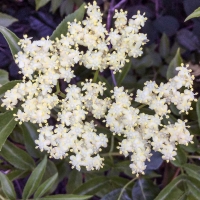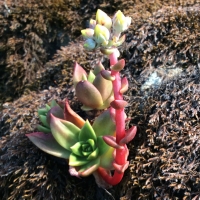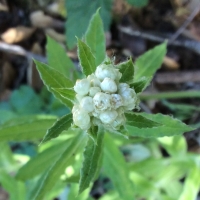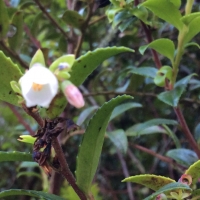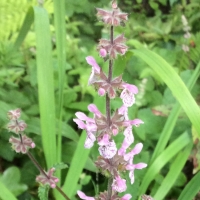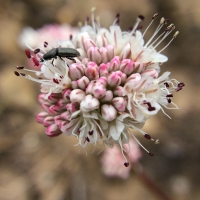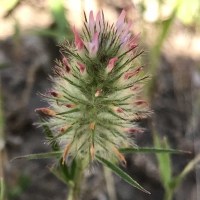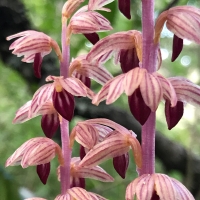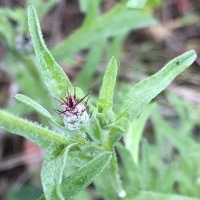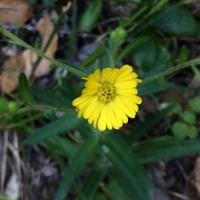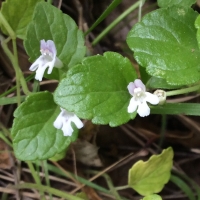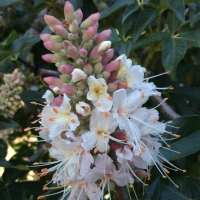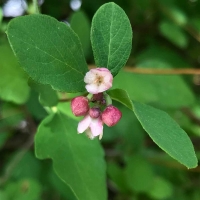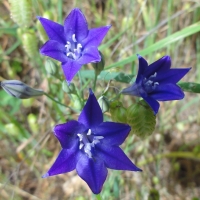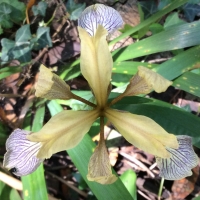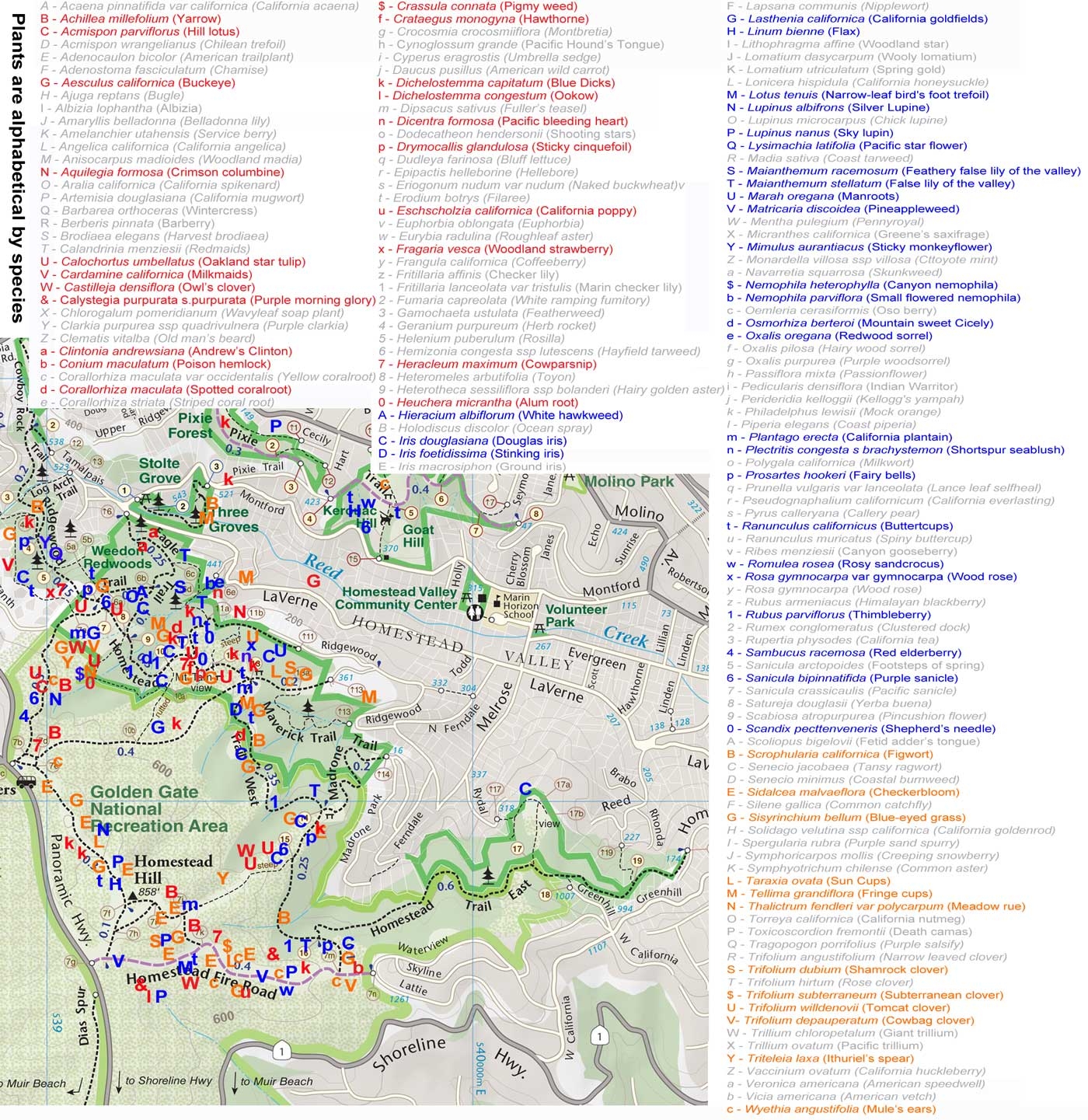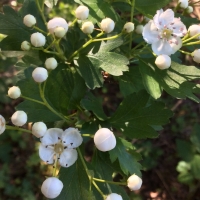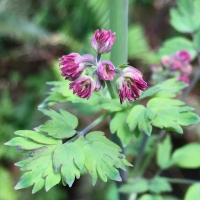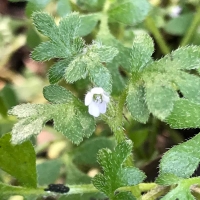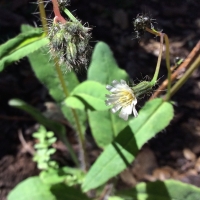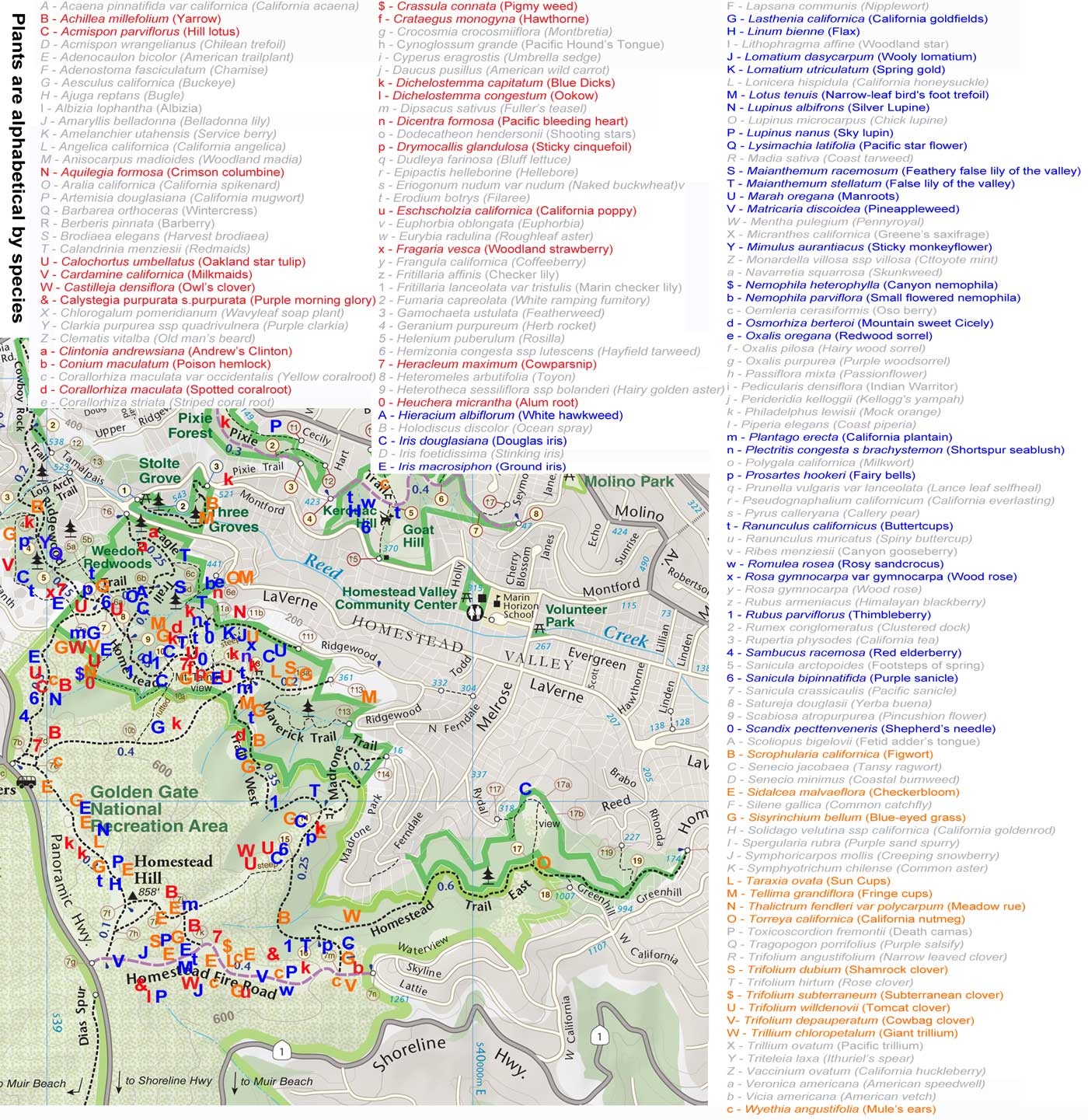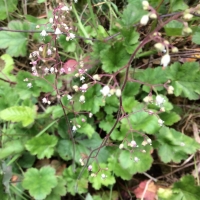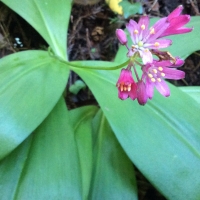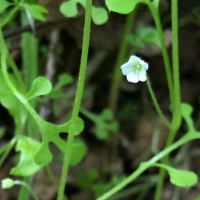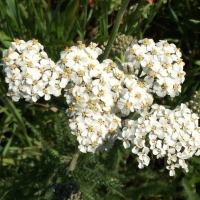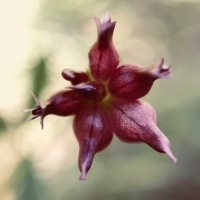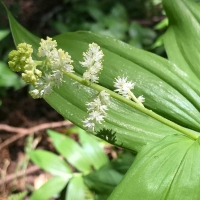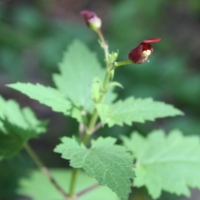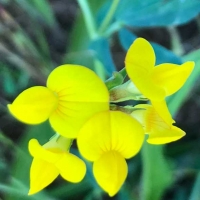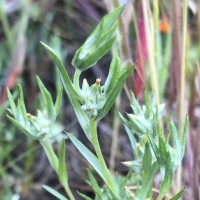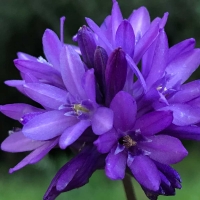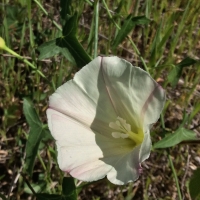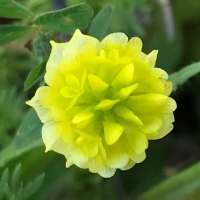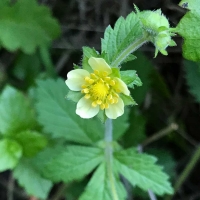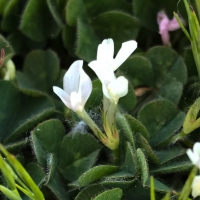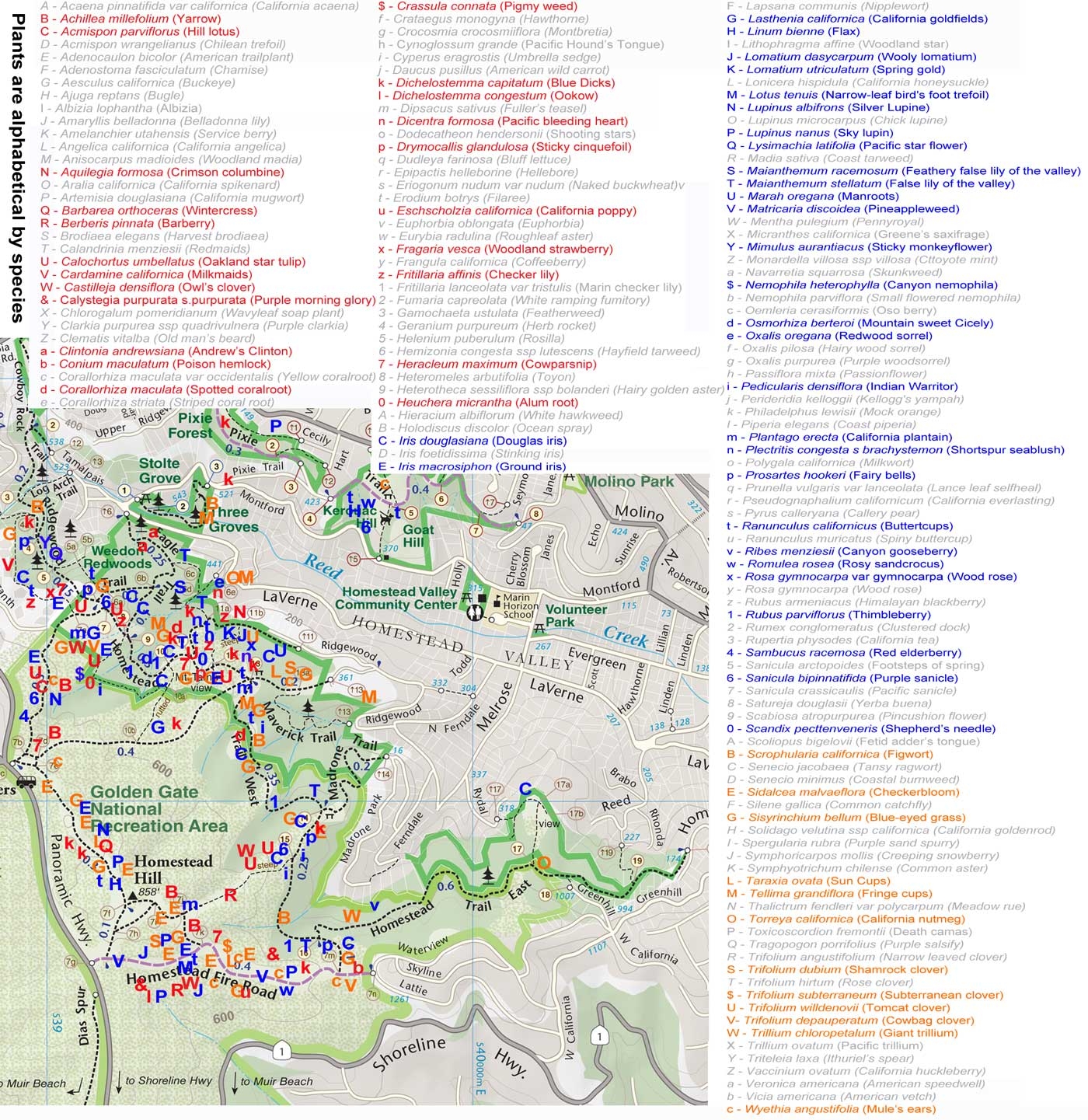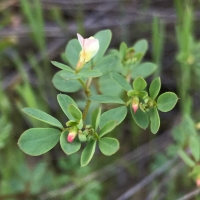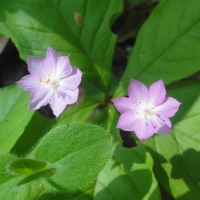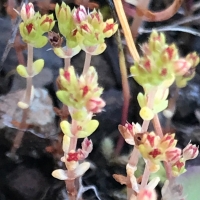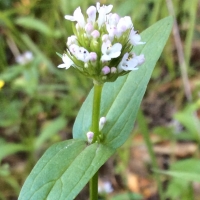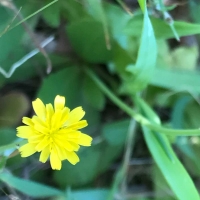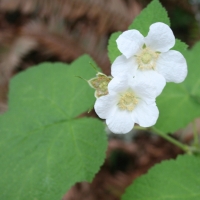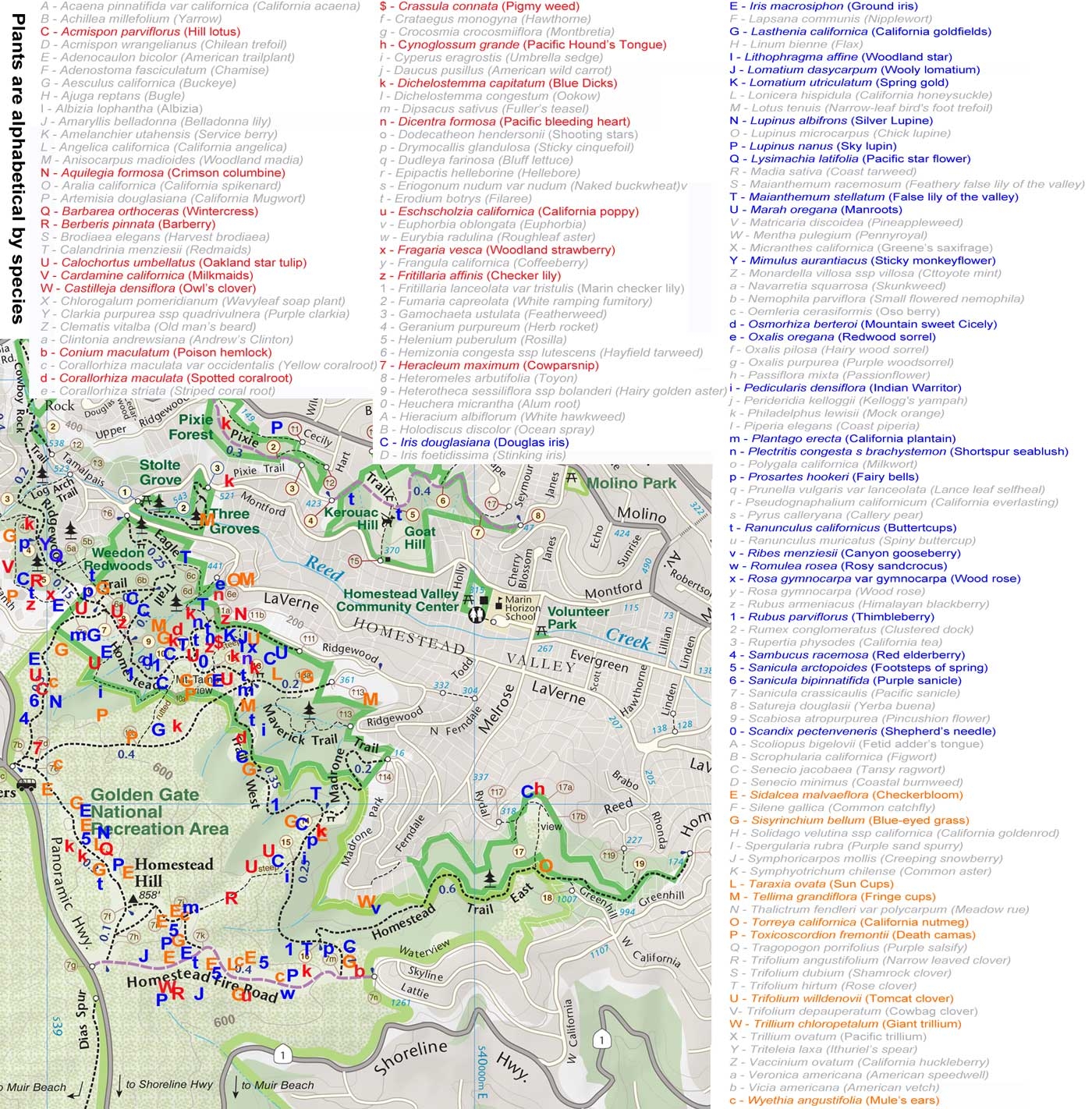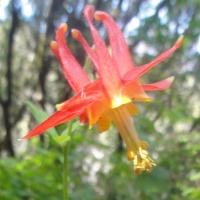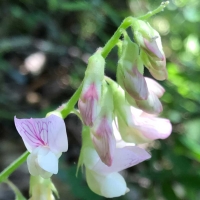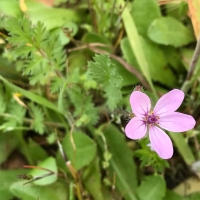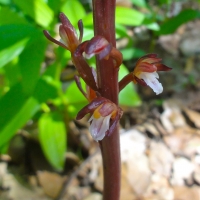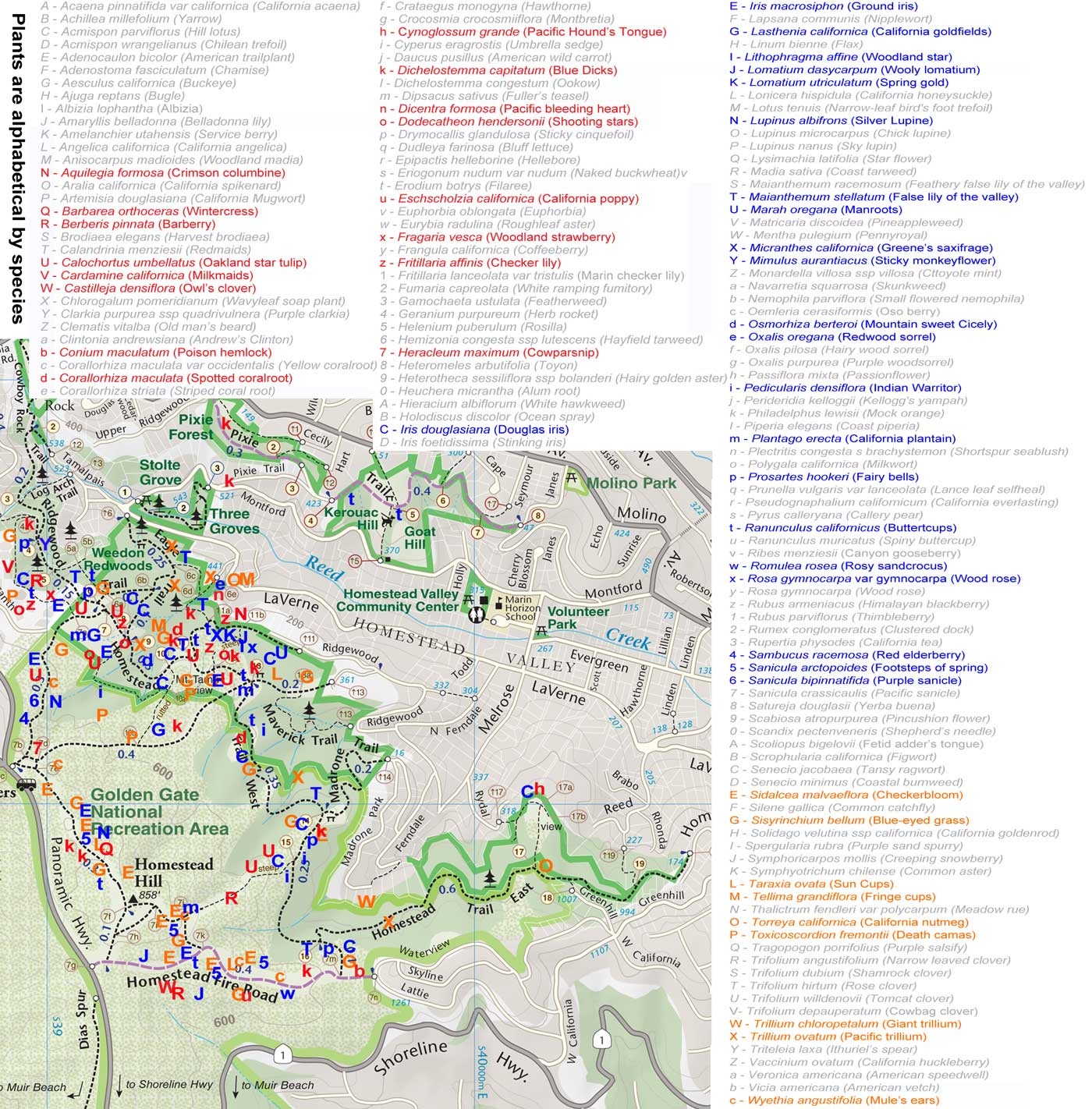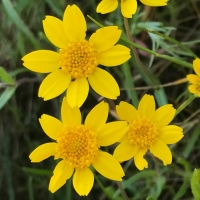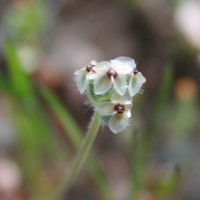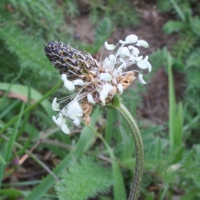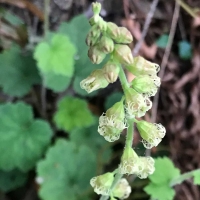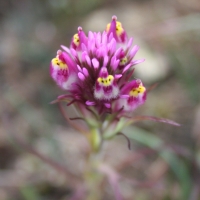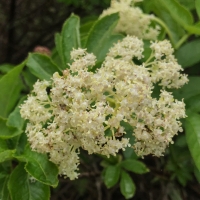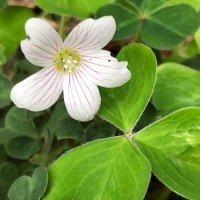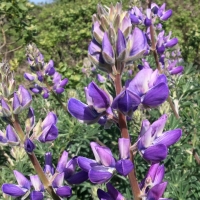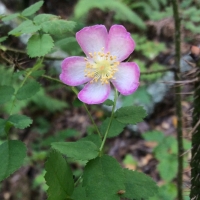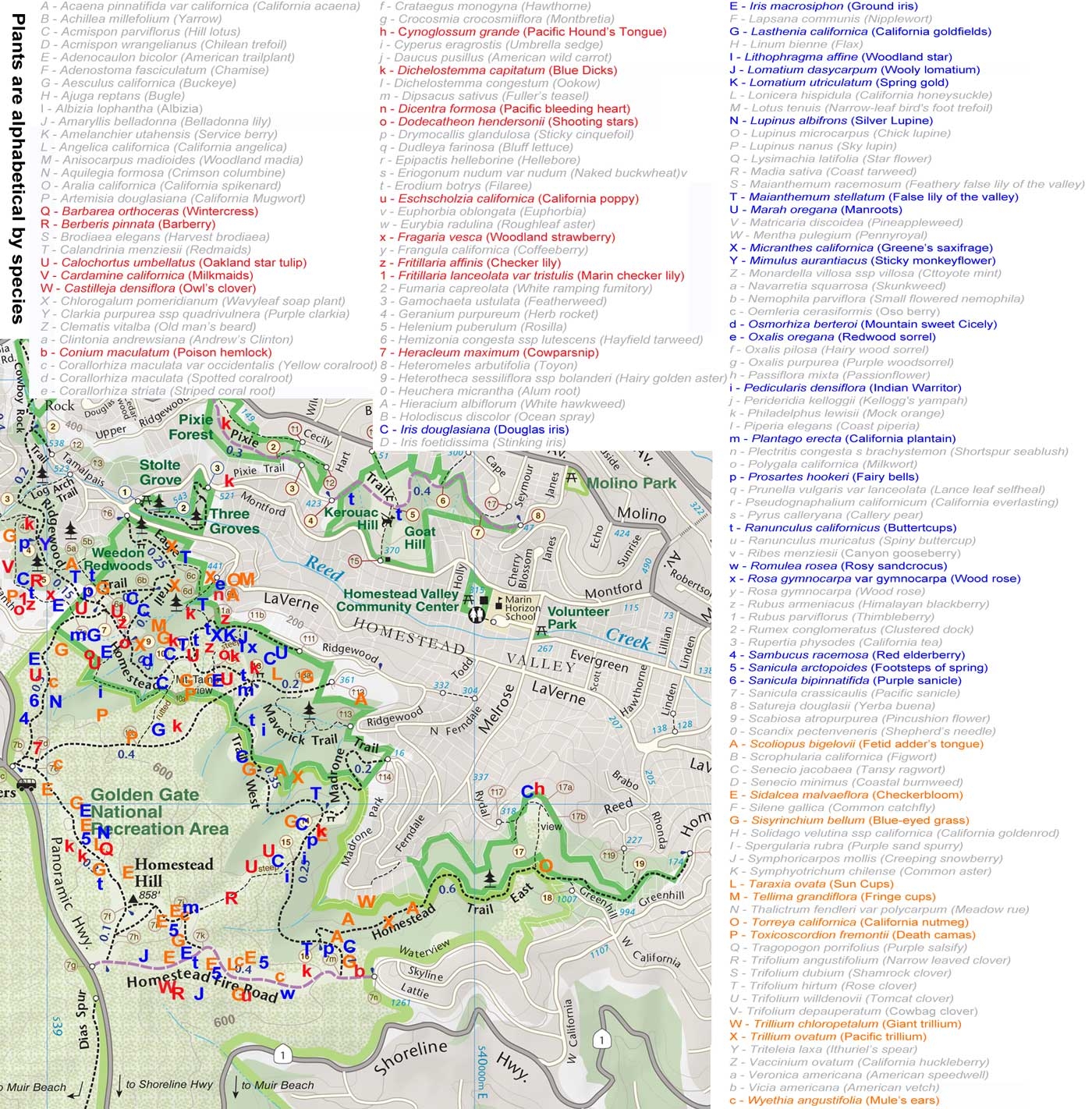NEW
– Black elderberry, a large shrub with clusters of white flowers is blooming near Panoramic below the fire road.
– Bluff lettuce, a succulent, is blooming with yellow flowers on red stalks.
– California everlasting has clusters of tight white flowers and blooms in meadows.
– California huckleberry blooms with small white bells on the Red Plum Trail. A blueberry cousin, the berries once black are edible.
– Common catchfly*, native of Eurasia, blooms white on a reddish stalk in meadows.
– Hedgenettle, a mint, blooms in purple rounds up a stalk in forests.
– Naked buckwheat blooms in pink clusters on rock outcrops in meadows.
– Narrow leaved clover*, native of Eurasia is blooming pink tipped on the ridge.
– Striped coralroot, an orchid, is a spectacular find under the bays near 6d.
– Tocalote*, native of the Mediterranean region is an invasive weed found in meadows another unfortunate byproduct of ranching.
– Wavyleaf soap plant blooms with open white stars on long stalks. Pollinated by moths, the flowers open late in the day.
– Woodland madia’s bright yellow flowers bloom in forests.
– Yerba buena, a bright green ground hugging trailing plant is blooming with small white flowers. Leaves aromatic. Edible.
Forests
– Alum root, with frothy white bell flowers and geranium-looking foliage, blooms in cool seeps.
– Andrews clinton, a lily of the redwood understory blooms bright pink on long stalks out of waxy bright leaves. A roadside wildflower, see it on the bank of Laverne above Stolte Grove.
– Canyon nemophila blooms small and white in cool seeps.
– Douglas iris is blooming white in the forests.
– Fairy bells’ cream flowers bloom under their ladder of leaves so you have to look under to see the bells.
– False lily of the valley carpets the forest with its white star flowers.
– Forget-me-not*, native of Europe, is one of the most invasive plants of the Homestead forest. Its seeds form small burrs that animals spread deep into wild areas. Please, pull forget-me-nots wherever you see them; if they have seeds, carry out and dispose.
– Pacific bleeding heart with its heart-shaped pink flowers and delicate foliage is blooming under the redwood trees next to 435 Laverne.
– Pacific pea, one of our native pea vines, blooms with delicate blush flowers in forests.
– Pacific sanicle’s dark, glossy, lobed leaves line the forest trails and their tall flower spikes are blooming now with mustard clusters.
– Pacific star flower’s delicate pink flower floats over low oval leaves in and is carpeting open areas in the forest.
– Poison oak blooms with small white star flowers. One of the most common plants in the forest understory, its oil causes itchy allergic reactions in many people.
– Redwood sorrel has a cream bell flower and is blooming under the redwood near 435 Laverne.
– Spotted coralroot, our most common orchid, blooms white throated on a red stem under oaks, sometimes in great profusion.
– Stinking iris*, native of Europe, blooms with khaki and purple flowers at a few spots along forest trails.
– Thimbleberry, a shrub with velvety maple leaf shaped leaves is blooming with large white flowers.
– White hawkweed blooms at the end of long stalks with white flowers.
– Wood rose, our native rose, is starting to bloom in the woods.
– Wood sweet-cicely, found throughout the forests of Homestead blooms with small white flowers.
Forest edges
– American vetch, one of our native pea vines is blooming purple.
– Buckeye trees are starting to bloom with large clusters of white flowers. Lining our roads, they make a beautiful display when fully blooming.
– California blackberry, blooms white, its vines distinctive from the non-native by its low creeping vine.
– Calla lily*, native to Southern Africa, has naturalized into wet seeps and is blooming white.
– Common snowberry’s little pink flowers are blooming on this small bush at forest edges.
– Cowparsnip with its large white umbels is blooming at the forest edge.
– Crimson columbine with its bright red and yellow flowers is blooming below the trail near 11a and below Amaranth, down slope before the first creek after 7a.
– Figwort blooms with a distinctive shaped rust red flower on a nettles-looking plant. Another roadside wildflower, look for it along wooded road cuts down at the start of Reed and throughout the forests. An important plant for bees and butterflies.
– Fringe cups blooms in forests along streams on tall stalks with pale green flowers with distinctive fringe edges that turn pink when fading.
– Latin American fleabane*, native of Central America, has colonized a small area below Amaranth.
– Manroot, the wild cucumber vine is blooming white.
– Miner’s lettuce with its white flowers at the center of an edible circular leaf is blooming in wet seeps.
– Small flowered nemophila, a low ground cover, blooms with small white flowers.
– Sticky cinquefoil, a tall, creamy yellow looking strawberry is blooming with columbine at the bridge near 12.
– White flowered onion*, native of the Mediterranean basin, is blooming in wet areas – edible.
– Woodland strawberry is blooming white up on the ridge below Homestead Hill.
Meadows
– Blue dicks is blooming with purple clusters in meadows.
– Blue eyed grass is blooming with glossy purple flowers in meadows.
– California buttercup, bright yellow and glossy is blooming in meadows.
– California plantain’s blooms with minute translucent petals.
– California poppy, orange and bright, it’s starting to bloom now and will continue late into the summer.
– Common yarrow with its tight white umbel is blooming in full sun on the ridge.
– Cowbag clover with its purple blooms that look like balloons is blooming in a wildflower meadow off the Homestead Fire Road.
– English plantain*, native of Eurasia, tall stalk is blooming with a white corolla.
– Field madder*, native of the Mediterranean, is blooming in meadows with little pink star flowers.
– Hill lotus, blooms small with blush colored pea flowers.
– Ithuriel spear, open clusters of purple flowers on a tall stalk, are starting to bloom in meadows.
– Mule’s ear with its bright yellow sunflowers is blooming in the ridge meadow.
– Narrow-leaf bird’s foot trefoil*, native of Europe, is blooming bright yellow on the ridge of Homestead Hill.
– Narrowleaf cottonrose*, a naturalized native of the Mediterranean region is blooming on the ridge of Homestead Hill.
– Ookow, taller with larger clusters than the more common, blue dicks, is blooming on the ridge of Homestead Hill.
– Pineapple weed grows on Homestead Fire Road, releasing its chamomile scent as you crush it underfoot.
– Purple western morning glory, a vine with pink to cream trumpet flowers is blooming on the ridge of Homestead Hill.
– Shamrock clover*, native of Europe is blooming with yellow dome flowers on the ridge of Homestead Hill.
– Oakland star tulip is blooming with its whiteish, mariposa lily-shaped flower in meadows and on the Homestead Trail.
– Owl’s clover’s pink tufts have yellow and white details and is blooming on the knoll near the Panoramic gate.
– Poison hemlock*, native of Europe has a delicate white umbel and mottled red stems. Poisonous, use gloves when weeding.
– Purple sanicle with purple puff flowers is blooming in meadows.
– Pigmy weed, a small succulent, is blooming with microscopic red flowers on the Ridgewood Rock.
– Red elderberry large shrub blooms with white clusters on the trail to Homestead Hill.
– Redstem filaree*, native of Eurasia, is blooming with its pretty pink flowers in full sun.
– Rosy sandcrocus*, native of South Africa, has a lovely pink flower and grows in meadows.
– Shortspur seablush, a white flower cluster is blooming white on the Ridgewood Rock.
– Silver lupine blooms purple on large silver leaved bushes up on the ridge.
– Sky lupine, bright blue with white grows in sun on Pixie and Homestead Hill.
– Sticky monkeyflower with its orange flower blooms in sunny spots and will bloom all summer.
– Subterranean clover*, native of Europe, is blooming along Homestead Fire Road on the ridge of Homestead Hill.
– Tomcat clover is blooming purple on the Ridgewood Rock.
Key to map:
I haven’t located plants on on the map if they are very prolific. Find them by their habitat.
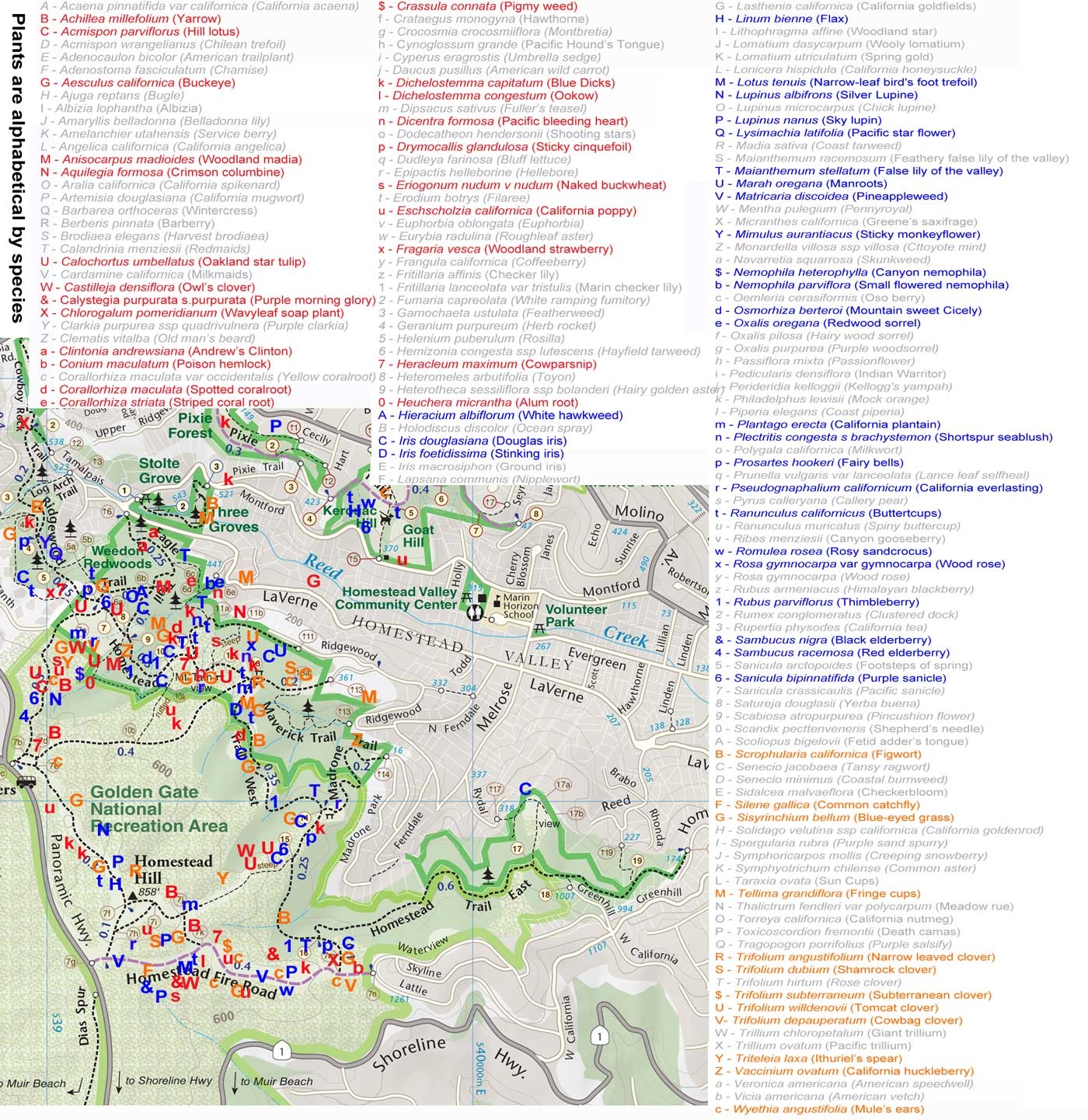
Gallery of wildflowers and plants found in Homestead.
*Non-native
Share this: